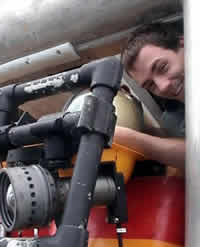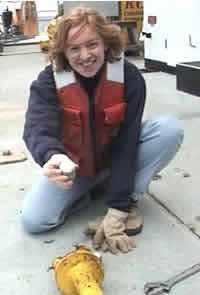| |
Teacher Logbook - NOAA Ship Ron Brown
| |

Sebastian
Durand from the University of Quebec at Montreal, is swapping out
a transducer on the ROPOS, to improve the ROV navigation. Sebastian
works as a navigator on this cruise, and is also collecting data for
his masters degree in biology.

Susan Kulp from the University of Florida
at Gainesville inserts the wax
cutters
into the rock corer. When ROPOS is out of the water other research
operations
take advantage of the ship to collect samples. 129 wax-corer previous
samples
have been collected on the NeMO cruises.
|
|
Jeff Goodrich's Sealog:
Axial Volcano South Rift Zone
July 19, 2001
Suddenly
ROPOS appears from the dark abyss below. ROPOS's huge winch is almost
finished with the laborious task of raising the vehicle for the hour and
a half that it takes to reach the surface. It slowly coils the metal cable
around and around. The seven person deck crew is ready to retrieve and
safely get the ROV back on deck. Once the 18,000 pound vehicle is tightly
tethered down the action doesn't stop. The scientists eagerly await its
arrival to collect their samples, getting the live specimens in the refrigerator
as soon as possible.
Under the
intense conditions of the ocean floor and with day and a half long dives,
ROPOS takes a beating. The ROPOS crew works around the clock and when
not flying the vehicle at the bottom, maintenance calls. The goal is always
to keep the turnaround time small and keep it in the water as much as
possible. As the scientists are busy with their samples, checking equipment,
and planning the next dive the ROPOS crew are fixing the feedback in the
7-function arm, changing out the transducer for the PS 8000 navigation
system (see photo top right), taking the hot fluid sampler off and exchanging
it for the bio-box and changing fibers in the down umbilical. Quite a
lot to do in a short period of time. This will take a couple more hours
than the usual 2-hour turn around time. When the action isn't on the seafloor,
it's on deck. This makes ship operations a 24-hour job.
No time is
wasted during maintenance. Geologist Susan Kulp (photo right) directs
the ship to steam an hour south of the caldera to the southern rift zone
of Axial Volcano (about 27 km) to conduct a basalt core. She sends a large
rocket-looking piston corer down 1922 meters to ram the bottom. On the
core are five cutters, or metal cups, that are filled with wax. The basalt
shards in the wax can then be brought up to the surface for mineral analysis.
124 basalt wax-core samples have been taken during the NeMO program, which
lends insight into the spatial and temporal patterns in the geochemistry
in the region, as well as the different magma sources for the Axial Volcano
rift zone eruptions.
|
|

